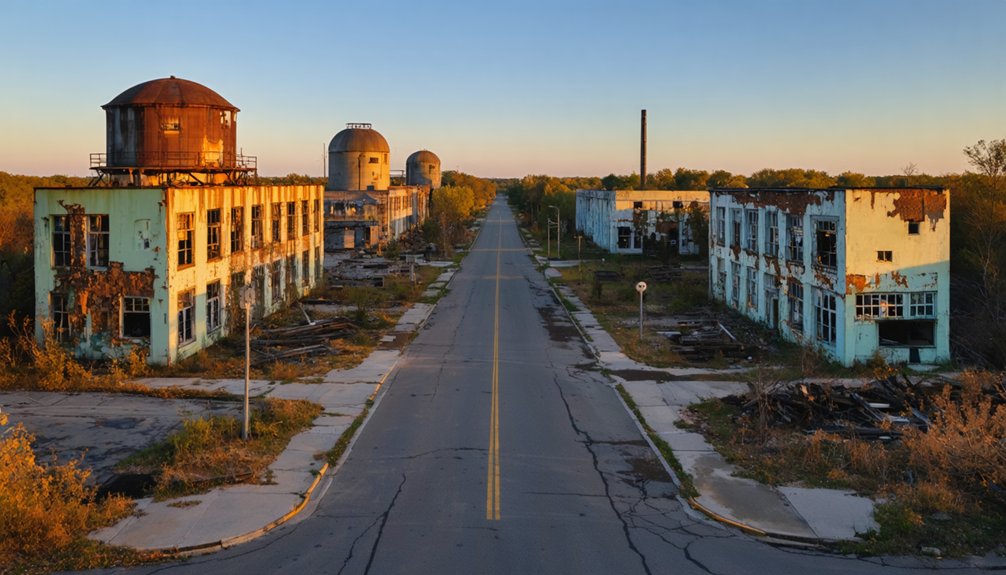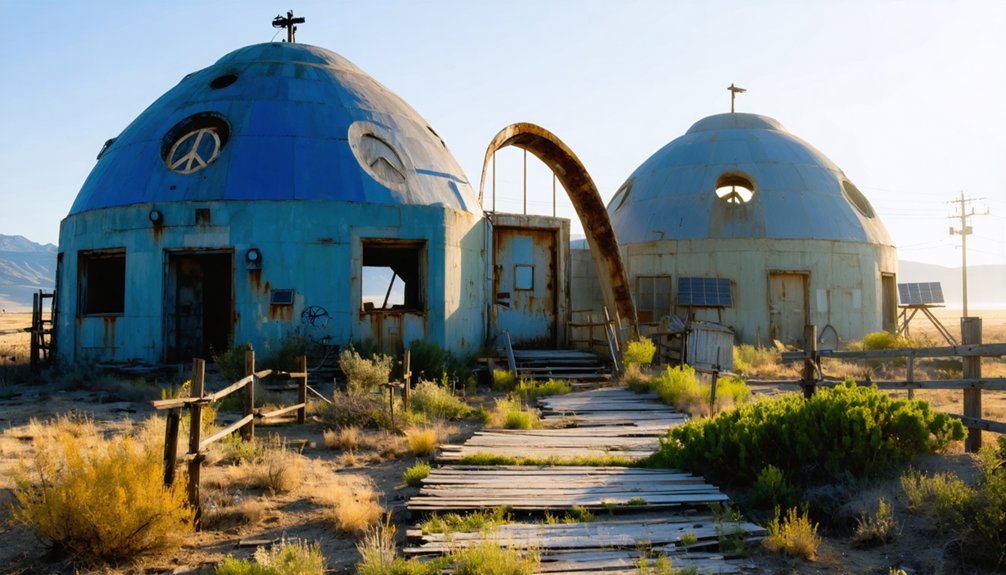America’s most fascinating abandoned utopian towns include New Harmony (Indiana), where Owen’s secular paradise collapsed by 1828; Brook Farm (Massachusetts), a Transcendentalist experiment with egalitarian pay; Harmony (Pennsylvania), the Rappites’ self-sufficient settlement; Oneida (New York), known for radical communal relationships before becoming a silverware company; and Amana Colonies (Iowa), where German Pietists maintained communal living for nearly a century. These architectural remnants reveal how idealistic social experiments transformed American landscapes.
Key Takeaways
- New Harmony, Indiana offers well-preserved 19th-century buildings and history from Owen’s failed 1825 secular utopia experiment.
- Harmony, Pennsylvania features architectural remnants in the Historic District showcasing the original Rappite religious community’s town plan.
- Oneida Community in New York transformed from a radical social experiment to a silverware empire, with preserved historic buildings.
- Brook Farm in Massachusetts failed by 1847 but maintains ruins and historical significance as a Transcendentalist utopian community.
- Amana Colonies in Iowa transitioned from true communalism to a corporation in 1932 while preserving much of their historical architecture.
New Harmony: Robert Owen’s Failed Secular Paradise in Indiana
While established settlements typically evolve organically over time, New Harmony emerged as a deliberate experiment in 1825 when Scottish industrialist Robert Owen purchased the ready-made town from George Rapp’s Harmonist Society for $150,000.
Owen’s Vision transformed the existing 180 buildings into a secular utopia without formal churches—remarkable for that era. You’ll find the physical layout reflected his egalitarian ideals, with shared spaces fostering the communal living he championed. Owen’s belief in the plasticity of character drove his design choices, as he sought to create an environment that would mold better citizens.
In New Harmony, architecture became philosophy—Owen’s secular spaces manifesting the radical equality he envisioned for humanity.
The Community Dynamics proved challenging, however, as the town attracted both sincere reformers and opportunists. Owen aimed to create a cultural hub by inviting scientists, philosophers, and artists to participate in his social experiment.
Despite establishing America’s first free library and pioneering educational reforms, internal conflicts and resource mismanagement led to the experiment’s collapse by 1828.
Today, this architectural representation of idealistic social engineering welcomes visitors seeking inspiration from its bold historical ambitions.
The Rise and Fall of Brook Farm’s Transcendentalist Experiment
Unlike New Harmony’s industrial foundation, Brook Farm emerged in 1841 from the intellectual soil of Transcendentalist philosophy when George Ripley, a former Unitarian minister, established his utopian experiment in West Roxbury, Massachusetts.
The community embodied Transcendentalist ideals through its egalitarian pay structure—$1 per day regardless of task or gender—and balanced intellectual and physical labor. The Brook Farm school was particularly innovative, emphasizing perfect freedom between students and teachers rather than traditional hierarchical relationships. Notable literary figures including Nathaniel Hawthorne were residents, though he eventually left due to conflicts with the community’s ideals.
At its zenith, 120 members embraced communal living in this “Institute of Agriculture and Education,” publishing progressive works and sharing governance through direct democracy.
Brook Farm’s transformation in 1844 to a Fourierist Phalanx marked its decline. The costly Phalanstery building burned in 1846, accelerating financial troubles that had plagued the experiment from its inception.
Harmony, Pennsylvania: The Original Rappite Settlement
Before Brook Farm’s Transcendentalist experiment had even been conceived, a different vision of communal perfection was taking root in Pennsylvania’s Butler County.
In 1804, Johann Georg Rapp led his followers to establish Harmony, transforming 4,500 acres into a model of self-sufficiency through Agricultural Innovations that turned unsuitable land into productive farmland.
The community’s distinctive Rappite Celibacy, adopted in 1807, marked their commitment to spiritual purification while awaiting the Millennium. The members’ initial attempts at vine and fruit culture proved unsuccessful, prompting them to adapt their agricultural focus.
Despite this practice eventually contributing to their decline, Harmony’s economic prowess was undeniable—within years, they’d constructed brick buildings replacing log cabins and expanded cultivated land to 2,000 acres.
Celibacy may have sealed their fate, but Harmony’s industrious spirit transformed wilderness into prosperity with remarkable speed.
You can still explore this architectural evidence of utopian vision in the Harmony Historic District, preserving the original town plan that once housed a thriving experiment in communal living.
Their belief in Christ’s second coming drove their communal work ethic, which later influenced their decision to relocate to Indiana and establish New Harmony in 1814.
Oneida Community: From Complex Marriage to Silverware Empire
As John Humphrey Noyes established the Oneida Community in 1848, he introduced a radical experiment in communal living that would transform a rural New York settlement into one of America’s most notorious utopian ventures.
You’ll find Oneida’s architectural legacy in the imposing Mansion House, where over 300 members practiced “complex marriage” – a system rejecting monogamy in favor of shared intimate relations. Their distinctive approach included coitus reservatus, focusing on intercourse without ejaculation. Members also participated in a planned scientific reproduction program called Stirpiculture to selectively breed children with desirable traits.
This perfectionist theology embraced communal property, collective child-rearing, and mutual criticism sessions to create their vision of heaven on earth.
While their social experiment dissolved by 1880, their industrial ventures thrived.
What began as a steel trap manufacturing operation evolved into a silverware empire that would sustain generations.
Ironically, this community that rejected capitalism created one of America’s most enduring commercial legacies, proving utopian ideals sometimes yield unexpected dividends.
Amana Colonies: How German Pietists Created an American Utopia
While the Oneida Community explored radical social arrangements in New York, another remarkable experiment was unfolding in the American heartland. German Radical Pietists, fleeing religious persecution, established the Amana Colonies across seven meticulously planned villages in Iowa by 1855.
Unlike many utopian ventures, this community survived nearly a century of true communal living. The colony was originally founded under the name Bleibetreu before adopting the more pronounceable “Amana.”
The Amana Colonies stand as a remarkable exception in utopian history, maintaining communal living for nearly 100 years.
Their innovative social structure eliminated wages while providing extensive care through shared resources. The Amana Society maintained over 50 communal kitchens where women prepared meals for all residents.
The colony’s economic foundation rested on diversified industries—woolen mills, furniture workshops, and agricultural production—all communally owned yet market-engaged.
Frequently Asked Questions
Are Any Former Utopian Communities Open for Overnight Stays?
You can enjoy former retreats at several converted utopian communities. Historic Rugby Village, Oneida Community Mansion House, Shaker Village, and Amana Colonies offer authentic community experiences with preserved architectural elements.
What Happened to Children Born in These Communal Societies?
Children experienced communal upbringing with shared responsibilities and education aligned with community ideologies. You’d find their childhood experiences varied from nurturing collective environments to challenging situations when communities dissolved, often leaving them to reintegrate into mainstream society.
Did Any Utopian Communities Practice Sustainable Agriculture Methods?
Yes, you’ll find sustainable practices across many utopian settlements. The Farm pioneered permaculture while indigenous initiatives like UTOPIA WA’s Fa’ato’aga demonstrated agricultural innovations balancing ecological rhythms with communal self-sufficiency and food sovereignty.
How Did Nearby Towns React to These Unusual Communities?
You’ll find community perceptions were often steeped in suspicion, while neighboring economies experienced mixed impacts—benefiting from increased trade yet sometimes resenting competition that operated outside conventional market frameworks.
Which Utopian Community’s Buildings Are Best Preserved Today?
You’ll find the Shaker villages most thoroughly preserved, with their distinctive architectural styles maintained through meticulous preservation techniques. Pleasant Hill’s thirty restored structures exemplify the Shakers’ functional, minimalist aesthetic within its historical context.
References
- https://open.baypath.edu/his114/chapter/utopian-communities/
- https://en.wikipedia.org/wiki/Wikipedia:WikiProject_Ghost_towns
- https://en.wikipedia.org/wiki/List_of_American_utopian_communities
- https://www.geotab.com/ghost-towns/
- https://guides.loc.gov/chronicling-america-early-utopian-communities
- https://www.youtube.com/watch?v=9sqf1Ayk3N0
- https://www.yesmagazine.org/health-happiness/2022/06/01/american-communes-failed-experiment
- https://en.wikipedia.org/wiki/Ghost_town
- https://www.nps.gov/articles/utopias-in-america.htm
- https://www.youtube.com/watch?v=ZAay8y6iHDY



